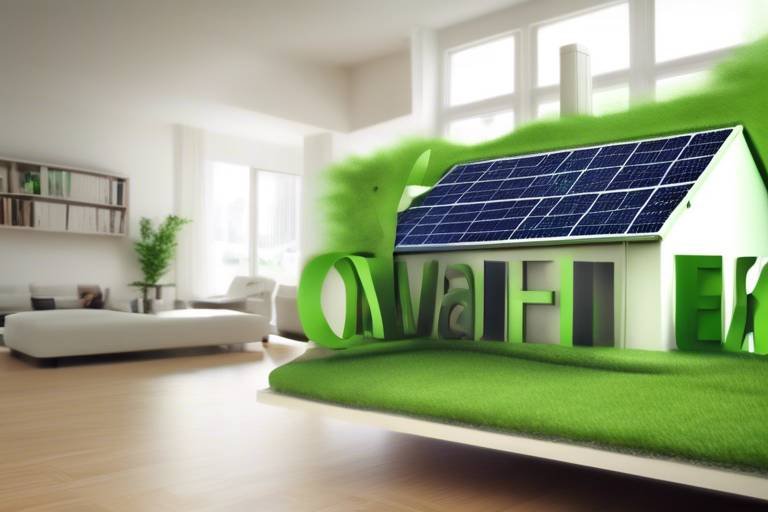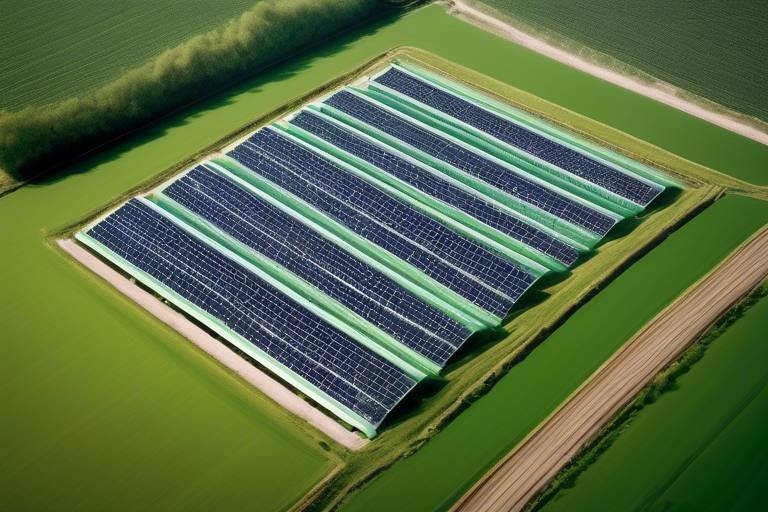Rethinking Power Generation - An Insight into Microgrids
In today's rapidly evolving energy landscape, the concept of microgrids is making waves, challenging traditional notions of power generation and distribution. These localized energy systems are not just a buzzword; they're a revolutionary approach to energy management that can operate independently or in tandem with the larger grid. Imagine a world where communities can generate, store, and consume their own energy, reducing reliance on centralized power sources. This article delves into the multifaceted world of microgrids, exploring their benefits, challenges, and pivotal role in shaping the future of energy.
At their core, microgrids are self-sufficient energy systems that can function autonomously or connect to the main electrical grid. They are composed of various components, including distributed energy resources (like solar panels and wind turbines), energy storage systems (like batteries), and advanced control systems that manage energy flow. Think of a microgrid as a mini power plant that can adapt to local energy needs. This flexibility enhances energy resilience, especially during outages or emergencies, allowing communities to maintain power when the larger grid fails. By providing a localized solution, microgrids can significantly reduce transmission losses and improve overall energy efficiency.
The advantages of microgrids are numerous and compelling. First and foremost, they significantly enhance energy security. By decentralizing energy production, communities can reduce their vulnerability to large-scale outages caused by natural disasters or other disruptions. Additionally, microgrids promote environmental sustainability by integrating renewable energy sources, thus lowering greenhouse gas emissions. The reliability of microgrids also cannot be overstated; they provide a stable power supply to critical facilities such as hospitals and emergency services, ensuring that essential services remain operational during crises.
Despite their many benefits, the journey to widespread microgrid adoption is not without its hurdles. Regulatory challenges often pose significant barriers. Many existing laws and regulations are tailored to traditional energy systems, making it difficult for microgrids to navigate the legal landscape. Furthermore, the initial costs of implementing a microgrid can be daunting, often requiring substantial investment in technology and infrastructure. Technological complexities also add to the challenges, as integrating various energy sources and storage systems demands advanced technical expertise. However, with careful planning and innovative solutions, these obstacles can be overcome.
The evolution of microgrids is heavily reliant on technological advancements. Innovations such as smart meters, which provide real-time data on energy consumption, and energy storage systems, which allow for the efficient use of renewable energy, are crucial. These technologies not only enhance the operational efficiency of microgrids but also empower consumers to make informed energy choices. For instance, when energy demand peaks, stored energy can be utilized, preventing strain on the grid and reducing costs. The integration of these technologies is paving the way for a more resilient and sustainable energy future.
Real-world examples of microgrid implementation showcase their potential and effectiveness. From the resilient microgrid in Brooklyn, New York, which integrates solar power and energy storage to provide reliable energy to its residents, to the innovative microgrid in Alaska, which utilizes local resources to power remote communities, these case studies illustrate the transformative impact of microgrids. Each of these examples highlights how microgrids can improve energy access, enhance sustainability, and foster community resilience.
The synergy between microgrids and renewable energy sources is vital for achieving sustainable development goals. Microgrids facilitate the incorporation of solar, wind, and other renewable sources, allowing communities to harness local energy resources. This not only reduces dependence on fossil fuels but also promotes cleaner energy solutions. As we transition towards a greener future, the role of microgrids in supporting renewable energy adoption becomes increasingly crucial.
Looking ahead, microgrids are poised to become a cornerstone of the global energy landscape. Emerging trends indicate a growing interest in decentralized energy solutions, driven by advancements in technology and increasing awareness of environmental issues. As more communities embrace microgrid technology, we can expect to see significant growth in this sector. The future implications of microgrid technology extend beyond energy generation; they have the potential to reshape economic structures, create jobs, and foster community engagement in energy management.
For microgrids to thrive, effective policies and regulations are essential. The current regulatory landscape often lacks the flexibility needed to accommodate these innovative systems. Policymakers must consider frameworks that support microgrid development, including incentives for renewable energy integration and streamlined permitting processes. By fostering an environment conducive to innovation, we can unlock the full potential of microgrids and pave the way for a more sustainable energy future.
- What exactly is a microgrid? A microgrid is a localized energy system that can operate independently or connect to the main power grid, enhancing energy resilience.
- What are the main benefits of microgrids? They offer improved energy security, reduced emissions, and enhanced reliability, making them a vital part of modern energy solutions.
- What challenges do microgrids face? Challenges include regulatory hurdles, high initial costs, and technological complexities that need to be addressed for successful implementation.
- How do microgrids integrate renewable energy? Microgrids can incorporate various renewable energy sources, such as solar and wind, allowing communities to utilize local resources and promote cleaner energy solutions.

Understanding Microgrids
Microgrids are localized energy systems that can operate either independently or in conjunction with the main power grid. Imagine a small island where the community generates and consumes its own electricity, without relying on the distant mainland. That’s the essence of a microgrid! These systems are designed to enhance energy resilience, providing a reliable source of power even during large-scale outages or disruptions. A microgrid can be powered by various energy sources, including renewable options like solar panels and wind turbines, as well as traditional fossil fuels. This flexibility allows them to adapt to local energy needs and resources.
At the core of every microgrid are several key components that work together to ensure efficient energy production and distribution. These components typically include:
- Distributed Energy Resources (DER): These are the actual energy generation units, like solar panels, wind turbines, or even combined heat and power systems.
- Energy Storage Systems: Batteries or other storage technologies that store excess energy for use during peak demand times or when generation is low.
- Control Systems: Advanced software and hardware that monitor and manage energy flow, ensuring that supply meets demand efficiently.
- Load Management: Strategies and technologies that help balance energy consumption, shifting usage to times when energy is plentiful and less expensive.
Microgrids can operate in two primary modes: grid-connected and islanded. In grid-connected mode, they interact with the larger power grid, allowing for energy exchange and backup support. Conversely, in islanded mode, they function independently, providing power to local users without any connection to the external grid. This capability is particularly valuable in emergencies when the main grid may fail, allowing communities to maintain essential services such as hospitals, water treatment facilities, and emergency services.
One of the most exciting aspects of microgrids is their potential to empower communities. By generating their own power, localities can reduce their dependence on centralized energy systems, which often face challenges related to aging infrastructure and transmission losses. Furthermore, microgrids can promote energy independence and sustainability, enabling communities to utilize local resources and reduce their carbon footprint.
As we look toward the future, understanding microgrids is essential for anyone interested in the evolution of energy systems. They represent a shift towards decentralized energy production, which not only enhances resilience but also supports the integration of renewable energy sources. In a world increasingly focused on sustainability, microgrids are not just a trend; they are a vital component of a cleaner, more reliable energy future.

Benefits of Microgrids
Microgrids are revolutionizing the way we think about energy consumption and distribution. Imagine a world where communities are not solely dependent on large, centralized power plants. Instead, they can generate, store, and manage their own energy through localized systems. This shift offers a plethora of benefits that can transform our energy landscape. One of the most significant advantages is improved energy security. By having the ability to operate independently from the main grid, microgrids can provide power during outages or emergencies, ensuring that critical services remain operational. For instance, hospitals, emergency services, and schools can maintain functionality even when the larger grid fails.
Another compelling benefit of microgrids is their potential to reduce greenhouse gas emissions. By integrating renewable energy sources such as solar panels and wind turbines, microgrids can significantly lower carbon footprints. This is particularly crucial in the fight against climate change, as the energy sector is a major contributor to global emissions. In fact, studies have shown that microgrids can reduce emissions by up to 50% when compared to traditional energy systems. This not only helps the environment but also aligns with the growing demand for sustainable practices among consumers and businesses alike.
Additionally, microgrids enhance reliability and resilience in energy supply. They can be designed to automatically switch between different energy sources based on availability and demand, ensuring a constant supply of electricity. This flexibility is invaluable, particularly in regions prone to natural disasters or extreme weather events. For example, during a hurricane, a microgrid can isolate itself from the main grid, allowing it to continue functioning while the larger network is down. This capability not only protects infrastructure but also supports community recovery efforts.
Moreover, microgrids foster economic growth by creating local jobs in the energy sector. From installation to maintenance, the development of microgrid systems requires a skilled workforce, which can stimulate the local economy. Furthermore, by generating energy locally, communities can keep more money circulating within their own economies rather than sending it to external energy providers. This local focus can lead to a more sustainable economic model, benefiting both residents and local businesses.
To put it simply, the benefits of microgrids are vast and varied. Here’s a quick overview:
- Energy Security: Independence from the main grid during outages.
- Reduced Emissions: Integration of renewable energy sources.
- Enhanced Reliability: Automatic switching between energy sources.
- Economic Growth: Creation of local jobs and keeping money within the community.
As we continue to explore the potential of microgrids, it’s clear that they offer a promising solution to some of the most pressing challenges in our energy systems today. They not only empower communities but also pave the way for a cleaner, more sustainable future. By embracing microgrid technology, we can take significant strides toward a resilient energy infrastructure that meets the needs of the present while safeguarding the environment for future generations.
Q: What is a microgrid?
A: A microgrid is a localized energy system that can operate independently or in conjunction with the main power grid, using various energy sources including renewables.
Q: How do microgrids improve energy security?
A: Microgrids can function independently during power outages, ensuring critical services remain operational.
Q: What are the environmental benefits of microgrids?
A: By integrating renewable energy sources, microgrids can significantly reduce greenhouse gas emissions and promote sustainable energy practices.
Q: Can microgrids stimulate local economies?
A: Yes, microgrids create jobs in installation and maintenance, and by generating energy locally, they help keep money within the community.

Challenges in Implementation
Implementing microgrids is not all sunshine and rainbows; it comes with its fair share of challenges that can make even the most enthusiastic energy advocates scratch their heads. One of the primary hurdles is the regulatory landscape. Different states and countries have varying rules regarding energy generation and distribution, which can complicate the establishment of microgrids. For instance, in some areas, existing regulations may not permit the sale of excess energy back to the grid, limiting the financial viability of microgrid projects.
Another significant barrier is the high initial costs associated with setting up a microgrid. While the long-term benefits are undeniable, the upfront investment can be daunting for many communities or organizations. This includes expenses related to infrastructure, technology, and the integration of renewable energy sources. Imagine trying to build a beautiful house but being faced with the reality of needing a substantial budget just to lay the foundation.
Furthermore, the technological complexities involved in microgrid systems can pose a challenge. Microgrids often require sophisticated technology to manage energy flow and maintain stability, which can be overwhelming for smaller entities without the necessary expertise. This is akin to trying to operate a high-tech gadget without a user manual—frustrating and often leading to mistakes that could have been avoided.
Moreover, there is a need for community buy-in. Microgrid projects often rely on local stakeholders for funding, support, and participation. If the community does not see the value or is unaware of the benefits, it can be challenging to gather the necessary support. To overcome this, education and outreach efforts are crucial. Engaging the community through informative sessions can help demystify the technology and highlight its potential advantages, making it easier for residents to embrace the change.
Lastly, the integration with existing infrastructure can be a tricky endeavor. Many regions have aging power grids that may not be compatible with modern microgrid technology. This necessitates upgrades or modifications to the existing systems, which can further escalate costs and extend project timelines. However, with careful planning and investment, these challenges can be addressed, paving the way for a more resilient and sustainable energy future.
In summary, while the road to implementing microgrids is paved with challenges, understanding these obstacles is the first step toward overcoming them. By addressing regulatory issues, managing costs, simplifying technology, engaging communities, and ensuring infrastructure compatibility, we can unlock the full potential of microgrids and usher in a new era of energy independence and sustainability.
- What is a microgrid? A microgrid is a localized energy system that can operate independently or in conjunction with the main power grid, providing enhanced energy resilience.
- What are the main benefits of microgrids? Microgrids offer improved energy security, reduced emissions, and enhanced reliability, transforming energy consumption patterns.
- What challenges do microgrids face? Microgrids encounter regulatory hurdles, high initial costs, technological complexities, community buy-in issues, and integration challenges with existing infrastructure.
- How can communities support microgrid projects? Community engagement through education and outreach is crucial for garnering support and understanding the benefits of microgrid technology.
- What role do renewable energy sources play in microgrids? Microgrids facilitate the integration of renewable energy sources like solar and wind, promoting cleaner energy solutions and sustainability.

Technological Innovations
In the rapidly evolving world of energy, are the driving force behind the advancement of microgrids. These localized energy systems are not just a passing trend; they represent a fundamental shift in how we think about power generation and consumption. At the heart of this transformation are several key technologies that enhance the efficiency, reliability, and sustainability of microgrids.
One of the most significant innovations is the development of smart meters. These devices allow for real-time monitoring of energy consumption, enabling users to make informed decisions about their energy usage. Imagine having the power to track your energy habits minute by minute, adjusting your consumption patterns to save money and reduce waste. Smart meters do just that, providing data that can lead to more efficient energy management both at the individual and community levels.
Another crucial component is energy storage systems. With the rise of intermittent renewable energy sources like solar and wind, the ability to store energy for later use becomes vital. Technologies such as lithium-ion batteries and advanced flywheels allow microgrids to store excess energy generated during peak production times and release it when demand is high. This capability not only enhances the reliability of microgrids but also helps in stabilizing the grid during fluctuations. For instance, when the sun sets or the wind dies down, stored energy can be deployed to ensure a continuous power supply.
Moreover, the integration of renewable energy sources into microgrids is a game-changer. Solar panels, wind turbines, and even biogas generators can be seamlessly incorporated into microgrid systems. This integration not only reduces reliance on fossil fuels but also contributes to a significant decrease in greenhouse gas emissions. As the world grapples with climate change, the role of microgrids in harnessing clean energy becomes increasingly important. A microgrid powered entirely by renewables can operate independently, providing energy security even during larger grid outages.
To illustrate the impact of these technological innovations, consider the following table that summarizes the key technologies enhancing microgrid performance:
| Technology | Description | Benefits |
|---|---|---|
| Smart Meters | Devices that monitor real-time energy consumption. | Promotes energy efficiency and informed usage. |
| Energy Storage Systems | Technologies that store excess energy for later use. | Enhances reliability and stabilizes energy supply. |
| Renewable Energy Sources | Solar, wind, and biogas systems integrated into microgrids. | Reduces fossil fuel dependency and emissions. |
Additionally, the rise of artificial intelligence (AI) and machine learning is revolutionizing how microgrids operate. These technologies enable predictive analytics, which can forecast energy demand and optimize resource allocation. For example, AI can analyze historical data to predict peak usage times, allowing microgrids to adjust their energy distribution proactively. This not only improves efficiency but also enhances user satisfaction by ensuring that energy is available when it’s needed most.
As we look to the future, the convergence of these technologies points toward a more resilient and sustainable energy landscape. Microgrids equipped with smart meters, advanced energy storage, renewable energy sources, and AI-driven analytics are not just a vision—they are becoming a reality. By embracing these innovations, we can create a more sustainable and efficient energy future, transforming the way we generate and consume power.
- What is a microgrid? A microgrid is a localized energy system that can operate independently or in conjunction with the main power grid.
- How do smart meters work? Smart meters provide real-time data on energy consumption, helping users manage and reduce their energy usage.
- What are the benefits of integrating renewable energy into microgrids? It reduces reliance on fossil fuels, decreases greenhouse gas emissions, and enhances energy security.
- What challenges do microgrids face? Challenges include regulatory hurdles, high initial costs, and technological complexities.

Case Studies of Successful Microgrids
When it comes to understanding the real-world impact of microgrids, there's no better way than to explore some successful case studies. These examples not only showcase the potential of microgrids but also illustrate how they can transform energy systems in diverse settings. Let's dive into a few standout instances that highlight the effectiveness of microgrids in action.
One of the most notable examples is the Brooklyn Microgrid in New York City. This innovative project allows residents to generate, consume, and trade solar energy among themselves. By leveraging blockchain technology, participants can buy and sell energy directly from their neighbors, which fosters a sense of community while promoting renewable energy use. The Brooklyn Microgrid has not only helped reduce energy costs for its participants but has also contributed to a more resilient energy system that can withstand disruptions.
Another fascinating case is the University of California, San Diego (UCSD) microgrid. This campus is largely self-sufficient, producing about 93% of its energy needs on-site through a combination of solar panels, fuel cells, and a natural gas-powered cogeneration facility. The microgrid not only provides reliable power to the campus but also allows UCSD to reduce greenhouse gas emissions significantly. This model serves as an excellent blueprint for other universities and institutions looking to enhance their energy independence.
Moving to the international stage, the Islanding Microgrid in the Maldives is a remarkable example of microgrid technology being deployed in remote areas. This microgrid integrates solar energy with diesel generators to provide reliable electricity to island communities that would otherwise rely solely on expensive and polluting diesel fuel. The project has improved energy access for residents and is a shining example of how microgrids can contribute to sustainable development in vulnerable regions.
To provide a clearer picture of these case studies, here's a table summarizing key details:
| Microgrid | Location | Key Features | Impact |
|---|---|---|---|
| Brooklyn Microgrid | New York, USA | Peer-to-peer energy trading, solar generation | Reduced energy costs, enhanced community resilience |
| UCSD Microgrid | California, USA | Solar panels, fuel cells, cogeneration | 93% energy self-sufficiency, significant emissions reduction |
| Islanding Microgrid | Maldives | Solar integration, diesel backup | Improved energy access, reduced reliance on diesel |
These case studies illustrate that microgrids are not just theoretical concepts; they are practical solutions that can address real-world energy challenges. By empowering communities, enhancing energy security, and promoting sustainability, microgrids are paving the way for a more resilient energy future. As we continue to explore the potential of microgrids, it’s clear that they hold the key to transforming our energy landscape.
What is a microgrid?
A microgrid is a localized energy system that can operate independently or in conjunction with the main power grid. It typically integrates various energy sources such as solar, wind, and storage systems to enhance energy resilience.
How do microgrids improve energy security?
Microgrids enhance energy security by providing a reliable power source that can operate independently during grid outages. They can also reduce dependence on centralized power plants, making energy supply more resilient.
What are the main challenges of implementing microgrids?
Challenges include regulatory hurdles, high initial costs, and technological complexities. Addressing these challenges requires effective policies, financial incentives, and technological innovations.
Can microgrids support renewable energy integration?
Absolutely! Microgrids facilitate the use of renewable energy sources like solar and wind, promoting cleaner energy solutions and reducing greenhouse gas emissions.

Microgrids and Renewable Energy
As the world increasingly shifts towards sustainable energy solutions, microgrids have emerged as a pivotal player in this transformation. By integrating renewable energy sources such as solar, wind, and hydro, microgrids not only enhance energy resilience but also contribute significantly to reducing our carbon footprint. Imagine a community powered entirely by the sun, with solar panels on every rooftop and a microgrid that ensures energy is used efficiently and sustainably. This is not just a dream; it's becoming a reality in many parts of the world.
One of the most compelling advantages of microgrids is their ability to operate independently of the main power grid. This autonomy is particularly beneficial during natural disasters or outages when traditional systems fail. For instance, during Hurricane Sandy, many communities with microgrids managed to maintain power while others were left in the dark for days. This resilience is largely due to the incorporation of renewable energy sources that can be harnessed locally, making communities less dependent on centralized power systems.
Furthermore, the integration of renewable energy into microgrids creates a symbiotic relationship that benefits both the environment and the economy. By utilizing locally sourced energy, communities can reduce transmission losses associated with long-distance electricity transport. This not only leads to cost savings but also promotes energy independence. With the right technological innovations, such as energy storage systems and smart meters, microgrids can optimize the use of renewable resources, ensuring that energy is available when it’s needed most.
However, the journey towards fully realizing the potential of microgrids and renewable energy is not without its challenges. High initial investment costs and the need for advanced technology can be significant barriers. Yet, as the technology matures and becomes more accessible, the prospect of widespread adoption becomes increasingly likely. In fact, many governments and private entities are investing in research and development to create more efficient and affordable solutions.
To illustrate the impact of microgrids on renewable energy, consider the following table that outlines key benefits:
| Benefit | Description |
|---|---|
| Energy Security | Microgrids can operate independently, ensuring continuous power supply during outages. |
| Reduced Emissions | Utilizing renewable sources significantly lowers greenhouse gas emissions. |
| Cost Efficiency | Local energy generation reduces transmission losses and costs associated with energy transport. |
| Community Resilience | Microgrids empower local communities to manage their energy needs effectively. |
In conclusion, the relationship between microgrids and renewable energy is a cornerstone of the future energy landscape. As communities embrace this innovative approach, we can expect a shift towards cleaner, more reliable energy systems that not only benefit the environment but also enhance local economies. The potential for microgrids to revolutionize energy consumption patterns is immense, and with continued investment and technological advancements, we are on the brink of a new era in energy generation.
- What are microgrids? Microgrids are localized energy systems that can operate independently or in conjunction with the main power grid.
- How do microgrids benefit renewable energy use? They optimize the use of locally sourced renewable energy, reducing reliance on centralized power systems.
- Can microgrids operate during a power outage? Yes, microgrids can function independently, providing power even when the main grid is down.
- What challenges do microgrids face? High initial costs, regulatory hurdles, and technological complexities are some of the challenges they encounter.

Future of Microgrids
The future of microgrids is not just bright; it’s practically glowing with potential! As we stand on the brink of a transformative energy revolution, microgrids are set to play a pivotal role in reshaping how we generate, distribute, and consume energy. Imagine a world where communities are not solely reliant on a centralized power system but can harness their own energy resources, making them resilient, sustainable, and self-sufficient. This vision is rapidly becoming a reality, thanks to advancements in technology and a growing recognition of the need for energy independence.
One of the most exciting aspects of microgrids is their ability to integrate seamlessly with renewable energy sources. Solar panels, wind turbines, and even energy storage solutions like batteries can be incorporated into microgrid systems, allowing communities to generate clean energy locally. This shift not only reduces reliance on fossil fuels but also minimizes greenhouse gas emissions, contributing to a healthier planet. In fact, according to recent studies, communities utilizing microgrids with renewable sources can reduce their carbon footprint by up to 50% compared to traditional energy systems.
Moreover, the rise of smart technologies is revolutionizing microgrid operations. With the implementation of smart meters and advanced energy management systems, microgrids can optimize energy usage in real-time. This means that energy can be distributed more efficiently, and consumers can actively participate in energy conservation efforts. The future will likely see a more interactive relationship between energy providers and consumers, fostering a culture of sustainability and awareness.
However, the transition to a microgrid-focused future is not without its challenges. Regulatory frameworks need to evolve to accommodate these localized systems. Policymakers must work hand-in-hand with industry stakeholders to create guidelines that not only support the development of microgrids but also protect consumers’ interests. This collaborative approach will ensure that microgrids can flourish in a fair and competitive energy market.
Furthermore, as technology continues to advance, we can expect to see significant improvements in energy storage solutions. Enhanced battery technologies will enable microgrids to store excess energy generated during peak production times and use it during periods of high demand. This capability will enhance the reliability and stability of microgrids, making them an even more attractive option for communities and businesses alike.
In conclusion, the future of microgrids is filled with promise. They represent a shift towards a more decentralized, resilient, and sustainable energy landscape. As we embrace these innovative systems, we can expect to see a transformation in how we think about energy consumption and production. The journey to a microgrid-powered future is just beginning, and it’s one that holds the potential for a cleaner, greener, and more equitable world.
- What is a microgrid? A microgrid is a localized energy system that can operate independently or in conjunction with the main power grid, enhancing energy resilience.
- How do microgrids contribute to renewable energy use? Microgrids can integrate renewable energy sources such as solar and wind, promoting cleaner energy solutions and reducing reliance on fossil fuels.
- What are the main challenges facing microgrid implementation? Challenges include regulatory hurdles, high initial costs, and technological complexities that need to be addressed for successful deployment.
- How can microgrids improve energy security? By allowing communities to generate and manage their own energy resources, microgrids enhance energy security and reduce vulnerability to grid failures.

Policy and Regulation
The integration of microgrids into the energy market is not just a technical challenge; it also involves navigating a complex landscape of policies and regulations. These frameworks can either facilitate or hinder the growth of microgrid technologies, making it essential for stakeholders to understand the current regulatory environment. In many regions, existing regulations were designed with traditional energy systems in mind, often leaving microgrids in a gray area. This can create significant barriers for developers and investors who are eager to harness the benefits of localized energy systems.
In order to promote the successful deployment of microgrids, several key aspects of policy and regulation need to be addressed:
- Interconnection Standards: Clear guidelines are needed to ensure that microgrids can connect seamlessly to the main grid. This includes technical specifications and safety requirements that protect both the microgrid and the larger grid.
- Incentives for Investment: Financial incentives, such as tax credits or grants, can encourage investment in microgrid projects. These incentives can significantly reduce the high initial costs associated with setting up microgrids.
- Regulatory Flexibility: Policymakers must adopt a flexible approach that allows for innovation. This means creating regulations that can evolve alongside technological advancements in the energy sector.
- Support for Renewable Integration: Policies that promote the integration of renewable energy sources into microgrids are crucial for achieving sustainability goals. This includes streamlined permitting processes for solar, wind, and other renewable installations.
Moreover, collaboration between government entities, utility companies, and private sector stakeholders is vital. By working together, these groups can develop policies that not only support microgrid deployment but also enhance overall energy resilience. For instance, some regions have successfully implemented pilot programs that allow microgrids to operate independently during grid outages, showcasing their potential to improve energy security.
As we look to the future, it is clear that effective policies and regulations will be the backbone of a thriving microgrid ecosystem. Policymakers must prioritize the creation of a regulatory framework that encourages innovation and investment, while also addressing the unique challenges posed by microgrids. This will not only facilitate the growth of microgrids but also contribute to a more sustainable and resilient energy future.
1. What are microgrids?
Microgrids are localized energy systems that can operate independently or in conjunction with the main power grid. They can generate, store, and distribute energy, providing enhanced energy security and resilience.
2. How do policies impact microgrid development?
Policies and regulations can either facilitate or hinder the growth of microgrids. Clear interconnection standards, financial incentives, and regulatory flexibility are crucial for successful deployment.
3. What role do renewable energy sources play in microgrids?
Renewable energy sources like solar and wind are integral to microgrids, promoting cleaner energy solutions and enhancing sustainability efforts. Microgrids can effectively integrate these renewable sources to provide reliable power.
4. Are there any successful examples of microgrid implementation?
Yes, there are several case studies worldwide that demonstrate the effectiveness of microgrids in improving energy access and sustainability. These examples highlight the potential benefits of localized energy systems.
Frequently Asked Questions
- What exactly is a microgrid?
A microgrid is a localized energy system that can operate independently or in conjunction with the main power grid. Think of it as a mini power plant that can generate, store, and distribute energy right where it’s needed, making it a game-changer for energy resilience.
- What are the main benefits of microgrids?
Microgrids offer a plethora of benefits! They enhance energy security by providing a reliable power source, reduce greenhouse gas emissions through the use of renewable energy, and improve overall reliability by minimizing outages. Imagine having your own power source that keeps your lights on, even when the main grid goes down!
- What challenges do microgrids face during implementation?
While the advantages are compelling, microgrids do encounter challenges. These include regulatory hurdles, high initial costs, and technological complexities. Overcoming these obstacles requires innovative solutions and supportive policies to pave the way for successful deployment.
- How do technological innovations support microgrid development?
Technological innovations are pivotal for microgrid efficiency. Smart meters, energy storage systems, and advancements in renewable energy sources like solar and wind power enhance the functionality of microgrids. It's like giving them a turbo boost to operate more effectively and sustainably!
- Can you provide examples of successful microgrid implementations?
Absolutely! There are several inspiring case studies showcasing successful microgrid implementations across the globe. These examples demonstrate how communities have improved energy access and sustainability through localized power generation, proving that microgrids can indeed make a difference.
- How do microgrids integrate with renewable energy sources?
Microgrids are designed to seamlessly integrate with renewable energy sources, such as solar panels and wind turbines. This integration promotes cleaner energy solutions and supports sustainable development, allowing communities to harness natural resources efficiently.
- What does the future hold for microgrids?
The future of microgrids looks incredibly promising! Emerging trends indicate that they will play a significant role in the global energy landscape, with potential growth areas in smart technologies and community energy solutions. It's an exciting time for energy innovation!
- What role do policies and regulations play in microgrid development?
Effective policies and regulations are crucial for fostering microgrid development. They create a supportive environment for investment and innovation, ensuring that microgrids can thrive within the energy market. Without the right framework, the potential of microgrids may remain untapped.



















